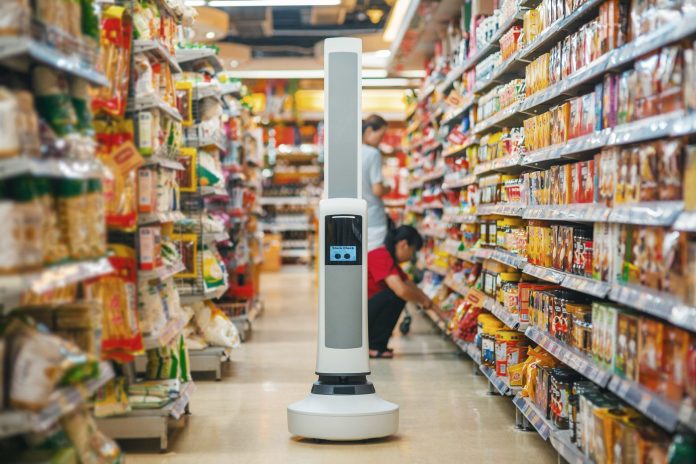The Heinen’s grocery store on Chippewa Road in Brecksville has deployed a new autonomous inventory robot called Tally, which customers can see roaming the aisles with its LED screen displaying messages like “Hi I’m Tally. I check shelf inventory.”
Tally is an autonomous robot developed by Simbe Robotics that simplifies inventory tracking and ensures shelves are always stocked. The robot scans shelves with 99% accuracy to give retailers a crystal-clear view of their inventory, pricing, and promotions, autonomously auditing aisles multiple times a day.
The slim-shaped robot is designed with considerate maneuvers that fit right into retail environments, gliding effortlessly through aisles with human-centered design and thoughtful movement to keep operations running smoothly without disrupting shoppers. The robot’s 2D and 3D shelf sensing suite delivers precision that captures every detail with advanced autofocus, auto-exposure, and depth perception.
Tally has an LED screen with blinking eyes that displays messages such as “Hi, I’m Tally” and “Let’s go!” instead of the googly eyes found on similar robots like Stop & Shop’s “Marty.” Tally can scan 15,000 to 30,000 products per hour and scan entire stores up to three times a day with 99% accuracy, compared to traditional weekly audits by store employees which achieve only 65% accuracy.
The robot processes near real-time shelf data both in the cloud and at the edge, delivering faster insights directly to mobile devices and store teams while helping Tally navigate and improve with every pass. Tasks are prioritized for associates through the Simbe Mobile App, while managers get reports, dashboards, and high-resolution images to drive strategic decisions.
Automation Trends Impact Ohio Workers
The Brecksville deployment comes as Ohio faces broader automation challenges in its labor market. Ohio is part of a five-state region that has consistently shown the highest robot adoption rates nationwide, typically at least twice the national average. Research shows that for every increase of one robot per thousand workers, the employment rate of young, less-educated workers in this region falls by 3.5 percentage points.
Despite adding more than 61,000 jobs in 2024, Ohio’s manufacturing sector lost over 4,000 jobs due to decreased demand and rising production costs. However, education, healthcare, and construction sectors drove growth.
Nationwide, 6 to 7.5 million retail jobs are at risk due to automation, with retail cashiers at highest risk. Women hold 73% of cashier positions, making them particularly vulnerable. About 16 million Americans work in retail, representing 10% of the nation’s workforce.
However, a survey of 1,100 retail workers found that 62% of grocery store employees believe technology will create new job opportunities, though 63% also agree that some duties will be replaced by technology. Industry experts emphasize that most in-store robots are designed to supplement, not replace, existing workers by handling repetitive tasks while freeing employees for customer service during labor shortages.
Interestingly, nearly two-thirds of retail workers are not worried about automation, with only 35% concerned about how technologies like AI could impact their roles. Younger workers show more concern, with 43% of Gen Z and 40% of millennial workers expressing worries about automation.
The Brecksville location follows a growing trend of grocery retailers implementing Tally robots. Similar robots are currently being piloted at Price Chopper/Market 32 and Tops Friendly Markets stores. SpartanNash has expanded Tally deployment to 15 stores after successful pilots, and Hy-Vee has also deployed the robots across multiple states.
Discover more from Northeast Ohio News
Subscribe to get the latest posts sent to your email.










